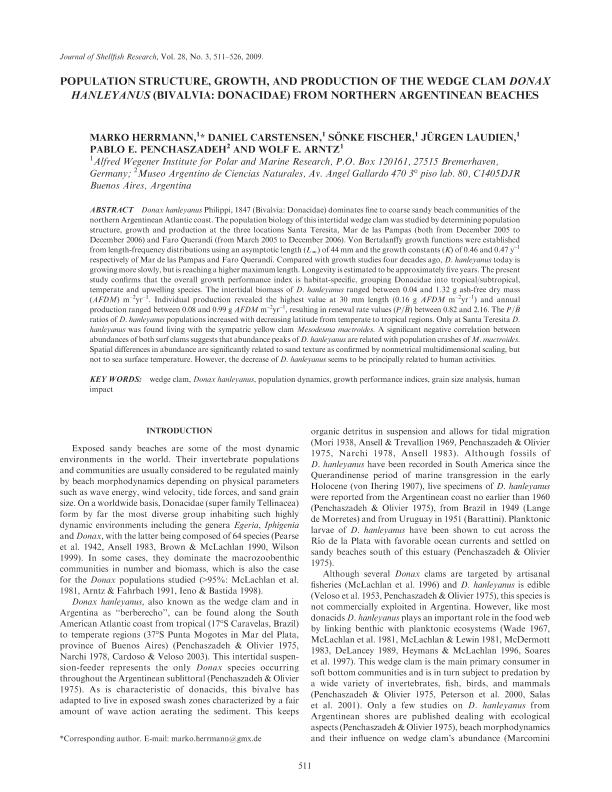Artículo
Population Structure, Growth, and Production of the Wedge Clam Donax hanleyanus (Bivalvia: Donacidae) from Northern Argentinean Beaches
Herrmann, Marko; Carstensen, Daniel; Fischer, Sönke; Laudien, Jürgen; Penchaszadeh, Pablo Enrique ; Arntz, Wolf E.
; Arntz, Wolf E.
 ; Arntz, Wolf E.
; Arntz, Wolf E.
Fecha de publicación:
08/2009
Editorial:
National Shellfisheries Association
Revista:
Journal of Shellfish Research
ISSN:
0730-8000
Idioma:
Inglés
Tipo de recurso:
Artículo publicado
Clasificación temática:
Resumen
Donax hanleyanus Philippi, 1847 (Bivalvia: Donacidae) dominates fine to coarse sandy beach communities of the northern Argentinean Atlantic coast. The population biology of this intertidal wedge clam was studied by determining population structure, growth and production at the three locations Santa Teresita, Mar de las Pampas (both from December 2005 to December 2006) and Faro Querandí (from March 2005 to December 2006). Von Bertalanffy growth functions were established from length-frequency distributions using an asymptotic length (L∞) of 44 mm and the growth constants (K) of 0.46 and 0.47 y-1 respectively of Mar de las Pampas and Faro querandí. Compared with growth studies four decades ago, D. hanleyanus today is growing more slowly, but is reaching a higher maximum length. Longevity is estimated to be approximately five years. The present study confirms that the overall growth performance index is habitat-specific, grouping Donacidae into tropical/subtropical, temperate and upwelling species. The intertidal biomass of D. hanleyanus ranged between 0.04 and 1.32 g ash-free dry mass (AFDM) m-2yr-1. Individual production revealed the highest value at 30 mm length (0.16 g AFDM m-2yr-1) and annual production ranged between 0.08 and 0.99 g AFDM m-2yr-1, resulting in renewal rate values (P/fi01_511.gif) between 0.82 and 2.16. The P/fi01_511.gif ratios of D. hanleyanus populations increased with decreasing latitude from temperate to tropical regions. Only at Santa Teresita D. hanleyanus was found living with the sympatric yellow clam Mesodesma mactroides. A significant negative correlation between abundances of both surf clams suggests that abundance peaks of D. hanleyanus are related with population crashes of M. mactroides. Spatial differences in abundance are significantly related to sand texture as confirmed by nonmetrical multidimensional scaling, but not to sea surface temperature. However, the decrease of D. hanleyanus seems to be principally related to human activities.
Palabras clave:
BIVALVIA
,
GROWTH
,
PRODUCTION
,
DONAX
Archivos asociados
Licencia
Identificadores
Colecciones
Articulos(MACNBR)
Articulos de MUSEO ARG.DE CS.NAT "BERNARDINO RIVADAVIA"
Articulos de MUSEO ARG.DE CS.NAT "BERNARDINO RIVADAVIA"
Citación
Herrmann, Marko; Carstensen, Daniel; Fischer, Sönke; Laudien, Jürgen; Penchaszadeh, Pablo Enrique; et al.; Population Structure, Growth, and Production of the Wedge Clam Donax hanleyanus (Bivalvia: Donacidae) from Northern Argentinean Beaches; National Shellfisheries Association; Journal of Shellfish Research; 28; 3; 8-2009; 511-526
Compartir
Altmétricas



